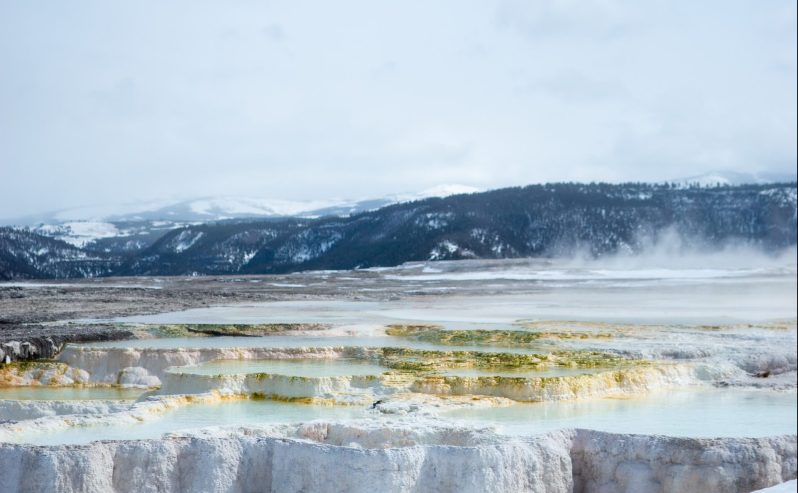
As the winter season starts to creep into your favorite US national parks, you might be thinking that it’s time to put away your hiking boots. Not so fast! There are several national parks that have trails open during the winter time. In this article, we’ll discuss four gorgeous national parks and what hiking opportunities lie in store for you.

Yellowstone National Park
While many roads are closed at Yellowstone National Park during the winter season, there are several trails that remain accessible to hikers. You’ll need to go to the North entrance in Montana because that’s the only one that’s open in winter. They have guided skiing and snowshoeing tours. Roads can close in snowy weather, so make sure you check the conditions before you visit.
- Old Faithful: See Old Faithful in the cold winter by booking a guided trip. Authorized tours provide insights into the geyser’s natural wonders.
- Mammoth Hot Springs: The Lower Terraces Trail at Mammoth Hot Springs provides a stunning tour of intricate terraces and is accessible in winter.
- Lamar Valley: This valley is known for its abundant wildlife, and winter is an excellent time to observe bison, wolves, and other animals against a snow-covered backdrop.
To make the most of your visit, consider these tips:
- Road closures and travel: Most park roads are closed to cars, but the road between the North and Northeast entrances remains open year-round. Limited snowmobile travel is available from mid-December to mid-March. Drive cautiously and use pullouts.
- Limited services during the winter: Most park facilities are closed during winter. Check winter operating hours and conditions by downloading the National Park Service app.
- Camping and lodging: Reserve accommodations well in advance at Old Faithful Snow Lodge or nearby communities. All campgrounds are closed during winter.
Yellowstone’s winter offers a unique and memorable experience. Plan ahead, respect the park, and embrace the serene beauty of the season. Whether it’s witnessing the magic of Old Faithful, encountering wildlife, or exploring snowy landscapes, Yellowstone’s winter promises an adventure like no other, worth every cold-weather moment.

Grand Teton National Park
Grand Teton National Park in Wyoming offers dramatic mountain landscapes and excellent winter hiking opportunities.
- Taggart Lake Trail: This moderate trail is relatively sheltered, making it a great choice for a winter hike with beautiful views of the Teton Range.
- Bradley Lake Trail: This year-round trail provides a unique perspective of the park in winter, with frozen lakes surrounded by the majestic Teton peaks.
- Jenny Lake: This trail is great for snowshoeing and takes about three hours to complete in the winter.
Here’s how to enjoy Grand Teton National Park:
- Park facilities and visitor centers: The National Elk Refuge and Greater Yellowstone Visitor Center remain open year-round.
- Winter facilities: Restrooms or portable toilets can be found at Taggart Lake Trailhead, Signal Mountain Lodge, Colter Bay Visitor Center, and Headwaters Lodge at Flagg Ranch. Gas stations with pay-at-the-pump service are available at Signal Mountain, Jackson Lake Lodge, and Headwaters Lodge at Flagg Ranch.
- Avalanche & backcountry information: If you plan to explore the backcountry during the winter, always check the local avalanche forecast and avoid known avalanche paths. Skiers and climbers traveling in avalanche terrain should carry and know how to use avalanche beacons, probe poles, and shovels.
Although some facilities close for the season, the Grand Teton National Park retains its captivating charm with opportunities for exploration and adventure.

Shenandoah National Park
Located in Virginia, Shenandoah National Park’s winter beauty is a hidden gem. While Skyline Drive may be closed on and off in winter, the park’s trails offer a peaceful escape.
- Dark Hollow Falls: This short, scenic hike leads to a picturesque waterfall which often freezes in the colder months.
- Limberlost Trail: This accessible trail takes you through a serene winter forest, perfect for those who prefer a leisurely walk.
- Bearfence Mountain: For those looking for a bit more adventure, the Bearfence Mountain Trail offers panoramic views of the surrounding Blue Ridge Mountains.
Make the most of your visit with:
- Spectacular scenic drives: While some park roads may close due to weather conditions, the Skyline Drive often remains open, providing an opportunity to enjoy breathtaking vistas of snow-covered mountains and valleys.
- Wildlife encounters: Winter offers a unique chance to observe wildlife in their natural habitat. Keep your eyes peeled for white-tailed deer, wild turkeys, and other cold-weather creatures as they forage for food in the quiet winter woods.
- Restrooms: The Dickey Ridge Visitor Center, Elkwallow Picnic Grounds, Thornton Gap Entrance Station, Panorama, Pinnacles Picnic Grounds, Byrd Visitor Center, South River Picnic Grounds, Swift Run Entrance Station, and the Dundo Picnic Grounds all have restroom facilities open in the winter.
Shenandoah National Park in the winter offers a fantastic escape for winter adventures that your family is sure to love.

Acadia National Park
It’s no surprise that Acadia National Park gets chilly in the winter, which makes it a great place to find some winter fun. While many trails may be icy, they can be a real win with the right equipment.
- Jordan Pond Path: This flat trail circles the scenic Jordan Pond, offering splendid views of the Bubbles mountains, especially when covered in snow.
- Gorham Mountain Trail: This moderate hike provides a mix of forest and coastal views. The trail is especially captivating with a fresh coat of snow.
- Cadillac Mountain: The South Ridge Trail up Cadillac Mountain can be a challenging winter hike, but the reward is an unparalleled view of the Atlantic Ocean and surrounding islands.
You can participate in a bunch of different activities like snowshoeing, ice fishing, cross-country skiing, and snowmobiling. Here’s why Acadia National Park is the perfect destination for cold-weather adventurers:
- Winter safety: This park can have unfavorable conditions and early darkness, so be prepared to turn back when necessary. Dress appropriately to guard against frostbite and hypothermia, and avoid relying solely on your phone for navigation or lighting.
- Leash requirement: Federal law requires that all pets must be kept on a leash no longer than 6 feet (1.8 meters). This rule is in place to protect wildlife and ensure the safety of all park visitors.
- Public restrooms: Seven public restrooms are maintained across the park throughout the winter, ensuring convenience and comfort for visitors.
Before embarking on a winter hike in any of these national parks, it’s essential to be prepared. Ensure you have the right clothing and gear, including warm layers, waterproof boots, and traction devices for slippery terrain. Travel in groups and carry bear spray. Checking trail conditions, weather forecasts, and park regulations is also crucial.



